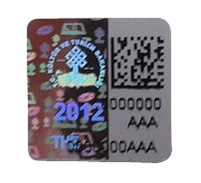A Timeless Anti-Counterfeiting Technology
23 September, 2012
The following article, which was provided to us and written by Sarah, Marketing Manager of InkSure Technologies is a natural follow-up to last weeks post regarding the difference between suspect and counterfeit notes. As I mentioned in that article it is a constant struggle for currency processors to accurately and consistently identify suspect notes. Although I categorically stated that machines are not by themselves capable of certifying a note as counterfeit, their are emerging technologies that can assist the human in getting closer to that certainty. In her article, Sarah describes a new application for a long-standing technology – that of the taggant. Although every spellchecker I possess does not know the word, Wikipedia offers the following…
A taggant is (also) a chemical or physical marker added to materials to allow various forms of testing. It is believed that they generally consist of microscopic particles built up in many layers, which are made of different materials. It is a somewhat secretive process, but products that may be affected include ink, paper, perfume, and medication. Taggants allow testing marked items for qualities such as lot number and concentration (to test for dilution, for example). In particular, taggants are known to be widely used in plastic, sheet and flexible explosives.
Taggants – A Timeless Anti-Counterfeiting Technology for Currency and Other Security Documents
by Sarah Hein, InkSure Technologies
Those of you without a background in anti-counterfeiting technologies probably don’t know what a taggant is, so let me explain. A taggant is a unique chemical composition used for identifying ownership. Taggants are added to items via carrier materials. In currency, a carrier material is usually one of the inks, varnishes or dyes used in the printing of a banknote. It is also possible to add taggants to banknotes via holograms and to coins via metal or a coating.
For the purpose of anti-counterfeiting, machine-readable taggants are used. Taggants are identified by a specially engineered reader programed to identify a specific taggant. Â Recently, a mobile app has come onto the market that can identify taggants in holograms, a common anti-counterfeiting apparatus used in banknotes.
Taggant technology (spectroscopy) and taggant-based solutions have been used as an anti-counterfeiting solution for over a decade. Spectroscopy is a mature and proven technology. With the right programing and equipment taggant-based solutions can guarantee almost 100% accuracy in the field. The recent advancements in smart phone technology which have made it possible for mobile phones to authenticate taggants in holograms upgrades the technology for 21st century needs.
One government agency, The Ministry of Culture and Tourism in Turkey, is currently using a smart phone authentication as part of The Ministry’s revenue collection program. The Ministry uses a mobile app developed by InkSure Technologies to authenticate and track the agency’s tax marks on cultural items such as CDs and books. (Tax marks are security documents with many of the same properties and security challenges as banknotes.)
The tax mark anti-counterfeiting protection is comprised of three parts:
1)Â Â Â Â A tax mark with a taggant and 2D barcode for authentication.
2)    The readers – A dedicated reader used by law enforcement and a mobile app used by the private sector to authenticate the tax marks in the field.
3)Â Â Â Â A track & trace system that records all readings taken by the mobile apps and readers.

The inclusion of a mobile app in The Ministry’s revenue collection program has greatly improved the reach and effectiveness of the tax marks. The mobile app is used by the brand owners and distributers of the products that are taxed to check for counterfeiting and other types of fraud. In turn the reading results from the mobile scans are collected by The Ministry’s track & trace system and used to analyze the supply chain and find hot spots of counterfeiting and gray market activity.
According law enforcement, the use of the mobile app by the private sector has allowed them to adapt a better approach to combating counterfeiting and piracy that are so prevalent with cultural items. By having a track & trace system that can analyze readings taken by a critical mass of law enforcement and brand owners, law enforcement can study counterfeiting and piracy “hot spots” and go after the heads of the underground crime rings. Previously, law enforcement’s main tactic in fighting counterfeit was to prosecute venders selling illegal items on the street, which skirts the root of the problem.
The positive effect can be seen in improved crime fighting statistics. In the first quarter of 2012 35 people were arrested for counterfeiting and piracy of cultural goods and approximately 3.5 million products were seized. By comparison only 2.5 million products were seized during 2004 – 2009.
A combination taggant-smartphone solution can have the same benefits for currency as it does for tax marks. Both documents have similar characteristics and similar usage. Many members of the public, not just government workers have an incentive to determine if tax marks and banknotes that come into their possession are fraudulent.
Taggant technology is a mature high security authentication solution, now available to smart phone users. This allows central banks to incorporate wide-spread machine-readable authentication to their currency anti-counterfeiting programs. Given the past and current success of taggant-based solutions, I think we can expect taggant technology to be used in currency anti-counterfeiting programs for many years to come.










